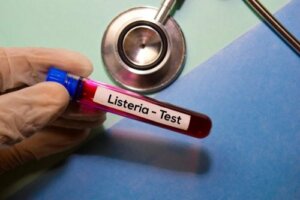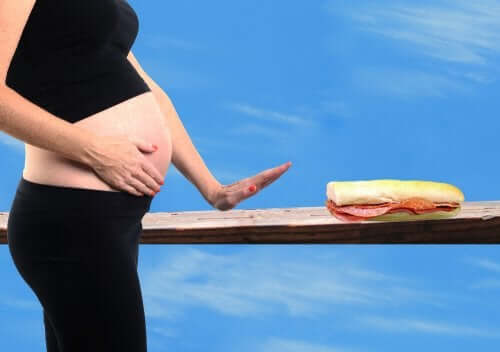Neonatal Listeriosis: An Illness that Deserves Our Attention

Detailed knowledge of the causes of neonatal listeriosis is an essential element of prevention and early diagnosis. This can have a positive impact on prognosis.
What is neonatal listeriosis and how does it occur?
Infection in utero with Listeria monocytogenes that causes neonatal listeriosis can result in fetal spread with the formation of granuloma. This can occur in a variety of areas, including the skin, liver, adrenal glands, lymphatic tissue, lungs, and brain.
At the same time, the aspiration or swallowing of amniotic fluid or secretions from the female genital tract can cause a lung infection in the uterus. It can also cause perinatal infection. This appears in the first days of a baby’s life through respiratory distress, shock, and fulminant development.
Signs and symptoms of neonatal listeriosis
Information from the Center for Disease Control (CDC) highlights that infections in pregnant women may be asymptomatic or characterized by a primary bacteremia. This is nothing more than the presence of the bacteria in the bloodstream. Its initial symptoms may be that of a nonspecific flu-like illness.

In the fetus and newborn babies, the way it develops depends on the time and route of infection. Miscarriage, premature birth, fetal death, or neonatal sepsis are common.
The infection can appear within hours or days of birth (early onset) or this can also delay until several weeks later. Neonatal listeriosis is, therefore, an illness we should take seriously due to its negative impact on a baby’s health.
Newborns with the early-onset disease are often underweight. They have associated obstetric complications, and show signs of sepsis or generalized infection soon after birth, with circulatory or respiratory failure, or both.
Newborns with the late-onset form are usually full-term, previously healthy, babies who later develop inflamed meninges or sepsis, or generalized infection.
To be considered
- Babies can acquire the infection in the womb or during delivery. Clinical manifestations can appear within hours or days of birth (early onset) or be delayed for up to several weeks (late onset).
- Early-onset listeriosis shows itself soon after birth as sepsis or generalized infection with circulatory failure, respiratory failure, or both.
- In late-onset listeriosis, previously healthy full-term infants may develop meningitis or sepsis.
- It’s essential to carry out a culture of L. monocytogenes – its causative agent – in pregnant women with febrile illness of unknown origin.
- Treatment consists of appropriate antibiotics.
- Pregnant women should avoid food products that may be contaminated with L. monocytogenes.
Treatment of neonatal listeriosis
The newborn baby will receive antibiotics and generally respond well to a 14-day course of medication (21 days for meningitis). However, doctors still don’t know the optimal duration.
Septic newborns, i.e. with widespread infection, require other measures. Doctors may consider drainage and other interventions in severe infections.
The essential factors are invisible to the naked eye
To paraphrase a remarkable statement in The Little Prince by Saint Exupery, pregnant women should avoid food products that may be contaminated by L. monocytogenes. These include unpasteurized dairy products, soft cheeses, raw vegetables, prepared cold cuts and salads, meat pastes, or chilled smoked seafood. Changes in food condition aren’t always visible to the naked eye.
Proper food handling, particularly the separation of raw meats from other items during preparation is vital. As is the washing of hands, utensils and cutting boards after handling raw foods.
If doctors detect an infection during pregnancy, then treatment can be given before delivery or intrapartum to prevent vertical transmission. However, the usefulness of this type of treatment hasn’t been proven.

To take into account…
- The clinical manifestations of listeriosis in newborn children are similar to those produced by other germs. However, there is a higher mortality than in the general population (20 – 60%). Based on these data, neonatal listeriosis is a disease that we should all take seriously.
- There are, therefore, two clinical manifestations. The first is early-onset listeriosis (within two days of delivery). This is a septicemic disease (a generalized infection when the causative germ has invaded the bloodstream) with vertical transmission from mother to fetus. The other is late-onset disease (five or more days after delivery), usually meningeal.
- The modes of transmission in the late-onset disease are poorly understood. They may result from transmission when the baby passes through the birth canal, contact with the mother during peripartum. Alternatively, they could also result from indirect nosocomial transmission with cases of early-onset disease through individuals or hospital equipment.
- Based on recommendations from the Centers for Disease Control and Prevention in the USA, “Most people with invasive listeriosis require hospital care and approximately one in five die from the disease.”
- When listeriosis occurs during pregnancy, it can cause miscarriage, fetal death, or death of the newborn. Listeriosis during pregnancy causes fetal loss in about 20% of cases and newborn death in about 3%.
More factors to take into account
- Scientists are well aware of the in vitro sensitivity of L. monocytogenes to the action of disinfectants. The persistence of the microorganism after cleaning and disinfection is a well-known problem in the food industry.
- The ability to persist in equipment and facilities is due to the bacteria’s ability to form biofilms and of becoming tolerant to the action of disinfectants.
- On the other hand, the bacteria is highly infectious. An infectious dose of at least 100 viable bacteria in the case of risk groups means that it can be easily transmitted by the hands of the personnel.
- Because listeriosis in hospitalized patients isn’t too frequent, doctors often don’t make the diagnosis too quickly. This, coupled with the fact that the disease has very long incubation periods (3 to 70 days), requires a high degree of alertness and makes epidemiological investigation of a possible outbreak difficult.
Finally…
The information we’ve shared with you shows that the different parts of the health service need to be extremely cautious. In this way they may help to prevent the acquisition of this disease in pregnant women, and in newborn children in both its early and later forms.
Detailed knowledge of the causes of neonatal listeriosis is an essential element of prevention and early diagnosis. This can have a positive impact on prognosis.
What is neonatal listeriosis and how does it occur?
Infection in utero with Listeria monocytogenes that causes neonatal listeriosis can result in fetal spread with the formation of granuloma. This can occur in a variety of areas, including the skin, liver, adrenal glands, lymphatic tissue, lungs, and brain.
At the same time, the aspiration or swallowing of amniotic fluid or secretions from the female genital tract can cause a lung infection in the uterus. It can also cause perinatal infection. This appears in the first days of a baby’s life through respiratory distress, shock, and fulminant development.
Signs and symptoms of neonatal listeriosis
Information from the Center for Disease Control (CDC) highlights that infections in pregnant women may be asymptomatic or characterized by a primary bacteremia. This is nothing more than the presence of the bacteria in the bloodstream. Its initial symptoms may be that of a nonspecific flu-like illness.

In the fetus and newborn babies, the way it develops depends on the time and route of infection. Miscarriage, premature birth, fetal death, or neonatal sepsis are common.
The infection can appear within hours or days of birth (early onset) or this can also delay until several weeks later. Neonatal listeriosis is, therefore, an illness we should take seriously due to its negative impact on a baby’s health.
Newborns with the early-onset disease are often underweight. They have associated obstetric complications, and show signs of sepsis or generalized infection soon after birth, with circulatory or respiratory failure, or both.
Newborns with the late-onset form are usually full-term, previously healthy, babies who later develop inflamed meninges or sepsis, or generalized infection.
To be considered
- Babies can acquire the infection in the womb or during delivery. Clinical manifestations can appear within hours or days of birth (early onset) or be delayed for up to several weeks (late onset).
- Early-onset listeriosis shows itself soon after birth as sepsis or generalized infection with circulatory failure, respiratory failure, or both.
- In late-onset listeriosis, previously healthy full-term infants may develop meningitis or sepsis.
- It’s essential to carry out a culture of L. monocytogenes – its causative agent – in pregnant women with febrile illness of unknown origin.
- Treatment consists of appropriate antibiotics.
- Pregnant women should avoid food products that may be contaminated with L. monocytogenes.
Treatment of neonatal listeriosis
The newborn baby will receive antibiotics and generally respond well to a 14-day course of medication (21 days for meningitis). However, doctors still don’t know the optimal duration.
Septic newborns, i.e. with widespread infection, require other measures. Doctors may consider drainage and other interventions in severe infections.
The essential factors are invisible to the naked eye
To paraphrase a remarkable statement in The Little Prince by Saint Exupery, pregnant women should avoid food products that may be contaminated by L. monocytogenes. These include unpasteurized dairy products, soft cheeses, raw vegetables, prepared cold cuts and salads, meat pastes, or chilled smoked seafood. Changes in food condition aren’t always visible to the naked eye.
Proper food handling, particularly the separation of raw meats from other items during preparation is vital. As is the washing of hands, utensils and cutting boards after handling raw foods.
If doctors detect an infection during pregnancy, then treatment can be given before delivery or intrapartum to prevent vertical transmission. However, the usefulness of this type of treatment hasn’t been proven.

To take into account…
- The clinical manifestations of listeriosis in newborn children are similar to those produced by other germs. However, there is a higher mortality than in the general population (20 – 60%). Based on these data, neonatal listeriosis is a disease that we should all take seriously.
- There are, therefore, two clinical manifestations. The first is early-onset listeriosis (within two days of delivery). This is a septicemic disease (a generalized infection when the causative germ has invaded the bloodstream) with vertical transmission from mother to fetus. The other is late-onset disease (five or more days after delivery), usually meningeal.
- The modes of transmission in the late-onset disease are poorly understood. They may result from transmission when the baby passes through the birth canal, contact with the mother during peripartum. Alternatively, they could also result from indirect nosocomial transmission with cases of early-onset disease through individuals or hospital equipment.
- Based on recommendations from the Centers for Disease Control and Prevention in the USA, “Most people with invasive listeriosis require hospital care and approximately one in five die from the disease.”
- When listeriosis occurs during pregnancy, it can cause miscarriage, fetal death, or death of the newborn. Listeriosis during pregnancy causes fetal loss in about 20% of cases and newborn death in about 3%.
More factors to take into account
- Scientists are well aware of the in vitro sensitivity of L. monocytogenes to the action of disinfectants. The persistence of the microorganism after cleaning and disinfection is a well-known problem in the food industry.
- The ability to persist in equipment and facilities is due to the bacteria’s ability to form biofilms and of becoming tolerant to the action of disinfectants.
- On the other hand, the bacteria is highly infectious. An infectious dose of at least 100 viable bacteria in the case of risk groups means that it can be easily transmitted by the hands of the personnel.
- Because listeriosis in hospitalized patients isn’t too frequent, doctors often don’t make the diagnosis too quickly. This, coupled with the fact that the disease has very long incubation periods (3 to 70 days), requires a high degree of alertness and makes epidemiological investigation of a possible outbreak difficult.
Finally…
The information we’ve shared with you shows that the different parts of the health service need to be extremely cautious. In this way they may help to prevent the acquisition of this disease in pregnant women, and in newborn children in both its early and later forms.
All cited sources were thoroughly reviewed by our team to ensure their quality, reliability, currency, and validity. The bibliography of this article was considered reliable and of academic or scientific accuracy.
- Listeria (Listeriosis). Centros para el Control y la Prevención de Enfermedades, CDC, EE.UU.
This text is provided for informational purposes only and does not replace consultation with a professional. If in doubt, consult your specialist.








